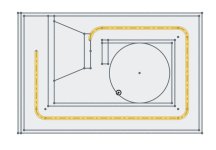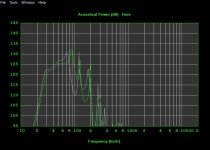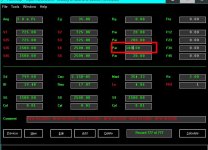Yeah so i bought a sub on a whim. Its a skar vxf 15 d4.
T/S Parameters
Bl 39.1 n/a
Fs 35.4 Hz
Re Dual 4 Ω
Sd 779.3 cm2
Cms 0.05 mm/N
Mms 384.3 gr
Qes 0.43
Qms 4.78
Qts 0.40
Vas 47.7 L
Nref 0.47%
Xmax 30 mm (one-way)
Sensitvity
88.7 dB
I plan on attempting to build an hroar box for it. So far i have modeled it in a roar box with very nice response from 26hz-80hz. I havent figured out how to translate bp8s function in hornresp to hroar, but i have a good idea what will work without modeling it. Ill post a hornresp response later today. I really have no particular need for this, i just want to build it and see what it does. Ill probably try it in my ht but inevitably it needs to be in an suv or something, so ill probably sell it haha. What would you do with it?
T/S Parameters
Bl 39.1 n/a
Fs 35.4 Hz
Re Dual 4 Ω
Sd 779.3 cm2
Cms 0.05 mm/N
Mms 384.3 gr
Qes 0.43
Qms 4.78
Qts 0.40
Vas 47.7 L
Nref 0.47%
Xmax 30 mm (one-way)
Sensitvity
88.7 dB
I plan on attempting to build an hroar box for it. So far i have modeled it in a roar box with very nice response from 26hz-80hz. I havent figured out how to translate bp8s function in hornresp to hroar, but i have a good idea what will work without modeling it. Ill post a hornresp response later today. I really have no particular need for this, i just want to build it and see what it does. Ill probably try it in my ht but inevitably it needs to be in an suv or something, so ill probably sell it haha. What would you do with it?
1. All your segments should be PAR.
2. With a 15" driver, L12 should be at least half the overall diameter of the driver. I usually use 8" or 20.32cm for easy mounting and removal.
3. Your STEPPED pic does not match your regular expansion model.
4. Double click on S1 to get STEPPED expansion.







2. With a 15" driver, L12 should be at least half the overall diameter of the driver. I usually use 8" or 20.32cm for easy mounting and removal.
3. Your STEPPED pic does not match your regular expansion model.
4. Double click on S1 to get STEPPED expansion.
Thanks for the reply bp1. The last segment is confusing to me because the way it was originally modeled there was a parabolic expansion representing a 45* angle from the second segment to the wall of the last segment. I think the only way to find out which is correct is to see which matches real world measurements.
Also, the pic i posted in post 2 is a bp8s hroar. I didnt post hornresp screenshots for that one. Ill post them later. I want to know if my schematic matches the hornresp model.
Also, the pic i posted in post 2 is a bp8s hroar. I didnt post hornresp screenshots for that one. Ill post them later. I want to know if my schematic matches the hornresp model.
Sorry for confusion i was trying to say that design is different from the model. Its an hroar. Tapped pipe with helmholtz resonator.
They are all some form of a TH.
I modified your numbers for a simpler build and smaller enclosure.






I modified your numbers for a simpler build and smaller enclosure.
Damn nice work man. You cranked that out fast. It takes me a long time to make that stuff.
Naturally, a normal positive flare TH will perform better than a stepped TH. Most likely, the TH has to bigger to get the same f3 as the stepped TH. Stepped TH is really for ease of construction, no angles.
I designed a stepped TH for Freddi on this forum. He had someone build it for him. He like the way it performed.
I built my self a negative flare TH for home theater.
Positive flare TH = efficient & big.
Straight flare TH = ease of build.
Negative flare TH = low & small.
Hofmann's Iron Law = efficient, low, small...pick 2.
Here's my build.








I designed a stepped TH for Freddi on this forum. He had someone build it for him. He like the way it performed.
I built my self a negative flare TH for home theater.
Positive flare TH = efficient & big.
Straight flare TH = ease of build.
Negative flare TH = low & small.
Hofmann's Iron Law = efficient, low, small...pick 2.
Here's my build.
Why not tune the second resonator lower ? If it gets near the second resonace in the TL section it sure ‘screams’
(Box gets incredibly huge so I should probably stfu😝)
(Box gets incredibly huge so I should probably stfu😝)
Last edited:
Don’t connect resonators together that share a resonance ?? If you do(it seems) you can expect some very intense ringing and decay issues?
If you connect 200 cm to 66.66cm, for example (they sort of share a resonace and it goes nuts) unless you want to create a unique sounding science experiment?
If you connect 200 cm to 66.66cm, for example (they sort of share a resonace and it goes nuts) unless you want to create a unique sounding science experiment?
Attachments
I built the enclosure from spare wood when I put two sealed 15's in my F150 SuperCrew in 2012. I could only go so big with the enclosure. With Hofmann's Iron Law, I chose low and small. I've been happy with enclosure for the past 13 years.
When I 1st built the T-TQWT in 2012, I was only powering the sub with a 280 watt Yamaha 5.1 AVR in 2 channel mode. The enclosure cracked multiple walls on multiple floors of the house. When Star Wars The Force Awakens came out on Blu-ray, Kylo Ren's force would cut off the Yamaha at my listening level. That's why I have the Dayton Audio SA1000 sub amp. The Yamaha run the Road Yamaha 18" bass bin in my work from home office.








When I 1st built the T-TQWT in 2012, I was only powering the sub with a 280 watt Yamaha 5.1 AVR in 2 channel mode. The enclosure cracked multiple walls on multiple floors of the house. When Star Wars The Force Awakens came out on Blu-ray, Kylo Ren's force would cut off the Yamaha at my listening level. That's why I have the Dayton Audio SA1000 sub amp. The Yamaha run the Road Yamaha 18" bass bin in my work from home office.
Do you use the PH1 function to model ALL your TH type enclosures?Don’t connect resonators together that share a resonance ?? If you do(it seems) you can expect some very intense ringing and decay issues?
If you connect 200 cm to 66.66cm, for example (they sort of share a resonance and it goes nuts) unless you want to create a unique sounding science experiment?
Why are S6, S8, and S9 populated in a 4 segment TH?
They’re zeroed out .
However, It is interesting to switch the second resonator section from parallel to series and watch how it affects the bandwidth in similar ways when this huge
However, It is interesting to switch the second resonator section from parallel to series and watch how it affects the bandwidth in similar ways when this huge
the driver seems to model better in series. not exactly sure how to convert series to parallel parameters properly. i know its only the eletrical properties that change, but if i leave everything the same except for re and bl, the model is very different. i wouldnt mind running it in series anyways. i think a pair of taramps hd2000 4ohm amplifiers would work pretty well. i would just wire one amplifier to each coil and they would get around 2500 clean watts a piece. the throat particle velocity should help the cooling somewhat. beyond that just being mindful about running 5kw to a 1500 rms sub should keep it from a meltdown. if not, the sub was $300. the whole idea is to see what could be done with little money and a single 15. nothing says it has to be run with that much power to be satisfying. i used brian steele's poc7 horn folding workbook. although i haven't built it yet, i like the idea of this design because of the location to the throat to the voice coil, the orientation of the woofer which keeps it perpendicular both laying down and standing up, and the direction the box is extended when the path length is changed. this box is 43"L*26.85"D*21.5"H. it should fit in any suv or crossover.




the screenshots are comparisons to the recommended enclosure, per manufacturer, of 3.25cf tuned to 32hz with 47.25in2 of port area. both are using 48db/octave filters keeping xmax below 30mm.





the screenshots are comparisons to the recommended enclosure, per manufacturer, of 3.25cf tuned to 32hz with 47.25in2 of port area. both are using 48db/octave filters keeping xmax below 30mm.
might be a good candidate for pro audio use, but i'm not entirely sure. you'd have to lower the wattage to a reasonable level i would guess 2.5kw would be good, and consider this driver is 50lbs. for home theater use, you would just increase the length of it to 56" stand it up and get something like this.




the punch at 80hz would be nice for music in a vehicle. considering cabin gain, it won't be as peaked as it looks here.Why not tune the second resonator lower?
- Home
- Loudspeakers
- Subwoofers
- So i impulse bought a sub. What would you do with it?


